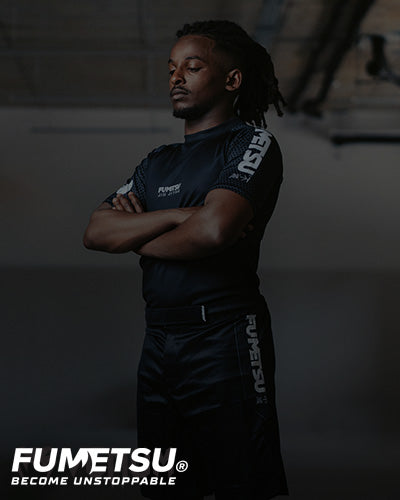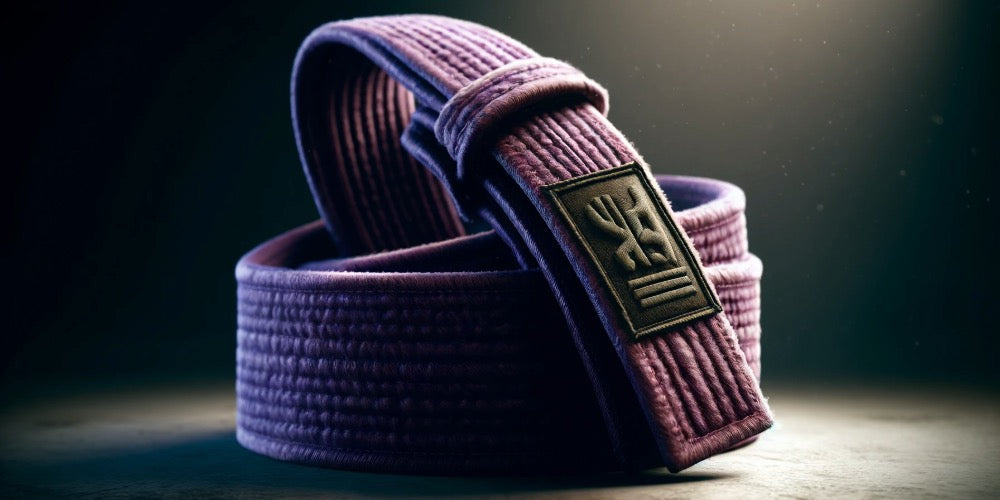Table of content
Similar to any martial art, progression through Brazilian Jiu Jitsu (BJJ) involves climbing through the ranks, each significant milestone being symbolised by a different belt colour.
What does it signify to hold a purple belt in Brazilian jiu-jitsu?
what should blue belts contemplate as they prepare for advancement to the purple belt level?
Earning a purple belt extends beyond mastering techniques; it's about refining your commitment, leadership skills, and distinctive approach in this deeply rooted martial art. So, let's explore the criteria for the Jiu Jitsu Purple Belt Requirements.
Understanding the Purple Belt
Anyone reading this is likely seeking to reach the purple belt and has likely already started on the path. A purple belt represents the practitioner who has moved beyond basic exercises to further introspect about the meaning of the art.
This stage is about more than just grappling techniques; it's about personal Jiu Jitsu style development and applying experimentation and strategy in techniques.
Achieving purple belt status means you've shown an intensive training commitment and an improving ability to teach and share knowledge. It's a rank that demands respect, both for the skill it represents and for the journey it signifies.

Key Requirements for Achieving a Purple Belt
Achieving a purple belt in BJJ involves various facets of development, both on and off the mat:
Dedication: The journey requires an unwavering commitment to training, often characterised by hours of practice, physical conditioning, and learning.
Leadership and Mentoring Roles: As you progress, you'll be expected to take on more responsibilities, guiding lower belts through their journey.
Personal Style Development: This phase encourages practitioners to begin crafting their unique approach to BJJ, exploring techniques that suit their strengths.
Experimentation and Strategy: Advanced techniques and strategies become a focus, with an emphasis on effective grappling and submission.
Physical Conditioning: A high level of fitness is crucial for advancement, supporting rigorous training and competition demands.
Competition Experience: Competing tests your skills under pressure and is essential for understanding practical application.
Understanding BJJ Principles: A deep philosophical and technical grasp of Brazilian Jiu Jitsu is expected, showcasing a well-rounded knowledge base.
Teaching Ability: Sharing your knowledge becomes an integral part of your journey, reflecting both your skill and your understanding of the art.
How much time is required to advance from a blue to a purple belt?
The International Brazilian Jiu-Jitsu Federation (IBJJF) mandates a minimum age of 16 for individuals being promoted to a purple belt. It also suggests a minimum training period of 2 years at the blue belt level before considering a move to purple belt.
Yet, the decision to promote a student involves various considerations beyond just time served.
Instructors look at a student's competence, grasp of techniques, and how they perform during practice sessions. Additionally, a positive mindset, consistent effort in training, and participation in competitions are crucial elements.
Typically, the journey from a white to a purple belt could span anywhere from 3 to 5 years.
Training and Gear for the Requirements
An intensive training regime is critical for anyone aiming to achieve purple belt status. This includes regular classes, sparring sessions, and competitions to test your skills in real-world scenarios.
Additionally, having the right gear is just as important. A quality purple belt signifies your rank and achievements, while durable training gear supports your journey, ensuring you're always prepared for the challenges ahead.
Consider exploring options like the Venum Brazilian Jiu Jitsu purple belt or the Kingz Golden Label V2 BJJ belt, both designed for practitioners who take their training seriously.
Beyond Techniques: Leadership, Teaching, and Personal Growth
Achieving a purple belt is a testament to one's dedication and hard work, but it also ushers in a new set of responsibilities. This rank brings with it an expectation to contribute back to the BJJ community through teaching and mentoring. Here's how:
- Leadership and Mentoring Roles: Purple belts often serve as a bridge between the instructors and lower-ranked students, offering guidance, support, and insight from their own experiences.
- Teaching Ability: The ability to convey complex techniques and concepts in an understandable way becomes crucial. This not only helps others but deepens the purple belt's own understanding of BJJ.
Competition: Testing Your Metal
Competitions play a crucial role in the life of a purple belt. They offer a unique opportunity to test skills against equally dedicated practitioners and provide a clear benchmark for personal development.
Yes, sparring (or "rolling") is often a key component of this journey. It's a great way to test your skills in real-life scenarios, receive feedback, and identify areas for improvement. Engaging in regular rolling sessions with your peers will not only prepare you for the challenges of competition.

FAQ: Understanding the Purple Belt in BJJ
How long does it take to get a purple belt in BJJ?
The journey to achieving a purple belt in Brazilian Jiu Jitsu varies significantly among practitioners, depending on factors like the frequency of training, individual aptitude, and competitive success. On average, it can take anywhere from 4 to 7 years of consistent training to attain this rank. This timeline assumes regular attendance at classes, active participation in sparring sessions, and possibly competition experience.
How many people make it to purple belt in jiu-jitsu?
Estimating the exact percentage of practitioners who achieve a purple belt is challenging due to the diversity of training goals and the personal commitments of individuals. However, it is widely acknowledged within the BJJ community that the drop-off rate decreases notably at this level. Those who earn their purple belts are generally highly dedicated to the sport, with a significant portion continuing their journey towards higher ranks.
Can a purple belt beat a black belt BJJ?
While a purple belt is an accomplished rank signifying a deep understanding of BJJ fundamentals and techniques, black belts represent the pinnacle of skill, experience, and knowledge in Brazilian Jiu Jitsu. Although it's not impossible for a purple belt to win against a black belt under certain conditions, such as a significant physical advantage or the black belt being out of practice, it is generally uncommon in competitive settings where both practitioners are actively training.
What rank is a purple belt in BJJ?
In the Brazilian Jiu Jitsu belt hierarchy, the purple belt is the intermediate rank that follows the blue belt and precedes the brown belt. It represents a transition from the beginner levels into the advanced stages of BJJ training. A purple belt practitioner is expected to have a comprehensive understanding of BJJ principles, techniques, and philosophies, showcasing significant personal and technical growth in the art.








